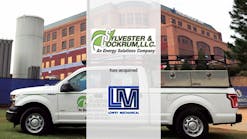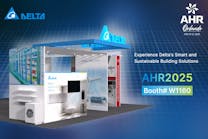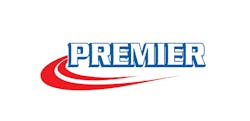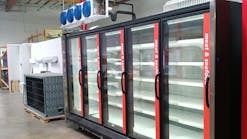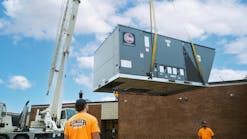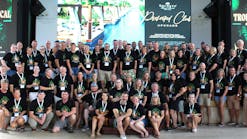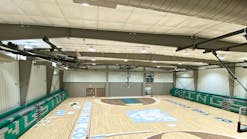The vast amount of information stored in data center servers across the US and around the world requires around-the-clock protection, from the twin perspectives of superior temperature control, and uninterrupted power.
This is the mission of Vertiv, a global, industry leader in data center cooling, and safe, reliable Uninterruptible Power Systems (UPS) for mission critical, data center and “Edge of Network” applications.
Vertiv operates 13 manufacturing and assembly centers in the US and Canada, as well as 80 North American service centers, and hundreds of service field engineers and technical support and response professionals.
Vertiv’s many capabilities and the breadth of its mission-critical solutions for contractors and data center customers, and its levels of customer support, came into focus during a recent visit to Vertiv’s Columbus and Westerville, Oh. facilities that house offices, manufacturing and an 11,000 sq. ft. training academy for contractors and end users.
Vertiv — formerly Emerson Network Power — offers a comprehensive range of thermal management and UPS solutions for data centers, communications networks, and commercial and industrial networks. All product solutions are accompanied by a full software suite and a global service organization.
Vertiv’s flagship brands are:
• Liebert® — thermal management and uninterruptible power supply systems for critical electronics. Founder Ralph Liebert virtually defined and set the standard for the data center protection industry
• Trellis™ —software for operations across IT and facilities resources
• NetSure — global engineered DC power systems for
converged networks
• Chloride® — global industrial power solutions
• EnergyLabs, Inc., a recently-acquired, privately owned, U.S.-based manufacturer of custom air handling systems.
Vertiv provides a complete lifecycle approach to service, from project launch to ongoing maintenance and performance optimization during the three key phases to every facility launch or equipment installation: project, maintenance and performance.
“Our goal with these combined brands is to manage all related critical applications, and be a full-service provider, from thermal management to power, for data centers and industrial types of power equipment, and related software applications and services,” said Greg Haggy, manager, strategic marketing for thermal management, North America. “We want to own the customer experience, from presale, through start-up, installation and commissioning, and then through post-sale product support during operation, to end-of-life. That’s our value: having all of the pieces associated with power and cooling, but also managing the entire lifecycle of that portfolio.”
Chillers, Packaged Units; Room, Row, Aisle Cooling
Vertiv’s thermal management portfolio for data centers includes: chillers from Liebert, for freecooling and adiabatic freecooling; packaged units for evaporative water and waterless cooling; Liebert room cooling units; and Liebert rack and in-row cooling.
Integrated offerings for data center rooms contain built-in cooling, and include: cabinet, row, and aisle thermal management solutions, as well as modular enclosures, and solutions to construct a complete data center infrastructure.
Answering Trends
Vertiv’s technical expertise and ongoing product development is guided by trends within the mission-critical industry, including: lower first cost, which is leading to more non-raised floor data center designs; high density capabilities and multi-story data centers; low water usage or no water usage; and the need for dedicated cooling and standardized delivery of cooling to edge spaces, as well as system monitoring, control and management.
“Five years ago, everybody was talking about energy efficiency, and people were willing to pay more for energy efficiency. Now, everything in the market is energy efficient to some degree, otherwise it wouldn’t have survived,” Haggy said. “So, if the customer has to choose between 10 different, highly-efficient solutions, they will ask, ‘Which will be more cost effective and easiest to deploy?’ And, many other factors have gained in importance, because those are the differentiators: the time it takes to install, the money it saves, and what it enables me to do from a building design or layout perspective,” Haggy explained.
For decades, the raised-floor method of providing cooling through perforated tiles was the industry standard. Today, concerns over construction footprints and the increased system density of larger data centers has caused the preference to shift to rooftop, perimeter or above-the-floor free-cooling systems.
“The data center market used to be comprised of a thousand different end-users who did their own designs,” Haggy explained, “and industry expertise was scattered. The easiest way to provide cooling in a data center was through a raised floor system, because you had that ‘cushion’ of air underneath, where all the equipment is. And if you could get air anywhere you put a perforated tile, it’s hard to screw it up. If you realized you had a hot spot somewhere, you would just put in another tile. It can be efficient when done properly but it’s harder to make it efficient.
In addition to the need for higher density data center cooling is a trend away from raised floor designs, as a way to reduce “first cost,” but also due to performance issues.
“With a raised floor, you’re going to be using the expensive underfloor area, or you will create the raised floor above the slab. But then you still have the structure of the floor, which may run into ceiling height issues. If you have a unit that is designed to take air under the floor, as simple as that sounds, how well can you circulate that air above the floor without being too high? Servers might need airflow to be more uniform, and getting that air [from under the floor] is a different challenge. We’re designing solutions that address that.”
“And, once you install the raised floor system, you’re locked into that for 20 years, as opposed to a slab floor with a modular set-up system, like our smart aisle configuration,” added Vertiv Marketing Manager Greg Myers. “With a ‘smart aisle’ application you can change it around completely five years from now, because it’s very modular, which customers like,” Myers said.
One of Vertiv’s new models — the DSE250 — is a split system that includes an indoor unit, refrigerant piping, and outdoor heat rejection.
“The DSE250 works with a raised or non-raised floor. The nice thing about split systems is that you’re running refrigerant piping, without ductwork, which can pose a challenge,” Haggy said.
Higher Density, Multi-level Data Centers
The trend to larger data centers needing extremely high density cooling is another major data center market influencer.
“A two- to three-megawatt data center used to be considered large. Today, that’s considered to be small or mid-sized, and a 15, 20, or 30-megawatt datacenter is considered to be large,” Haggy said. “That’s a trend we will continue to see as the big guys get bigger and squeeze out that middle part of the market.”
Haggy predicted that even 100-megawatt build-outs will become common.
Multi-story data centers are another major trend in data center construction, brought about by the high cost of real estate combined with a multitude of customers.
“The data center market has become concentrated into a few geographic regions: Northern Virginia, the bay area in California, and Northern Texas. You see these corridors in which there’s a huge amount of connectivity and fiber pipeline. Real estate becomes precious in those regions, so you’re seeing buildings going higher,” Haggy said.
Cooling for 'Edge' Spaces
Vertiv’s other cooling solutions apply to “edge spaces,” which are smaller, stand-alone data center locations that are not in “the cloud,” but rather, exist on “the edge,” with all data stored in-house.
A 2015 report by MarketsandMarkets found that this “micro data center” market would grow to be a $6.3 billion industry by 2020, driven by the Internet of Things revolution.
Edge spaces are usually ‘out of sight, out of mind,’ and will often be found in a converted rest room or storage area, but they also require attention and protection.
‘Insufficient cooling capacity is the top concern for edge spaces, followed by service and maintenance, improved monitoring, downtime, hot spots and insufficient power capacity,” said Ron Spangler, Vertiv senior product manager. Spangler added that other concerns are, insufficient floor space, effective management of new technology, and hot spots.
But the traditional robust, precision solution that will solve the problem may not fit the customers' budget. "They will tell us they want something that's less expensive and 'good enough." Fortunately, Vertiv mini-splits have entered that space and have gained a much better reputation," Spangler said.
Vertiv micro solutions include a Liebert SRC mini-split; Liebert DataMate (wall-mount); Liebert Mini-Mate (ceiling mount); Liebert PDX/PCW (perimeter); Liebert CRV (row-based).
Uninterruptible Power Supplies
Vertiv is also a leader in the design and manufacture of Uninterruptible Power Supplies (UPS) — those systems that provide the constant flow of electricity to keep a data center up and running. Vertiv provides a comprehensive range of power solutions for data centers, communications networks, and commercial/industrial networks.
Vertiv’s UPS products range from a single rack solution to systems for an entire building. Systems range in power from large (250kVA and higher), midsize (10kVA and higher) and small (5kVA and higher.). Its single-phase UPS systems are effective in mission-critical IT applications or Edge IT applications for racks, rows or data center rooms.
Additional “critical power” products by Vertiv include DC power systems, power distribution, industrial AC and DC systems, static transfer switches and power control and monitoring. Each tier involves the participation of electrical contractors, from installing to ordering and receiving delivery. A 2017 analysis of Vertiv’s UPS projects revealed that an electrical contractor was involved with more than 60 percent of projects, from ordering and receiving to installation.
Training is Essential.
Training through Vertiv Academy is an essential step in Vertiv’s services to customers. Nathan Markiecki is the acting director of the Academy, located in Westerville, Oh.
“From a training and skills standpoint, equipping everyone with the necessary product knowledge, so that they can be successful and be our partner in the marketplace is immense, and a huge contributor to Vertiv’s success,” Markiecki said.
Find much additional information online, at vertivco.com.
